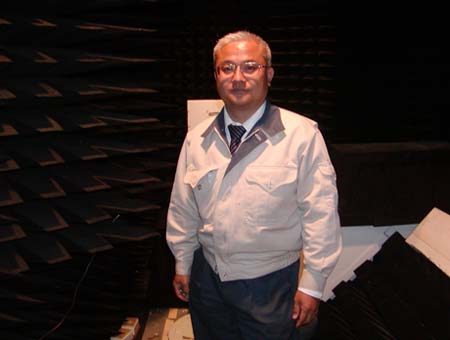Report on current operational status of small satellite "KKS-1"

Prof. Ryoji Wakabayashi in the Anechoic Chamber of his Laboratory
1. Operational status of KKS-1
APRSAF Secretariat
First, we would like to know about the operational status of KKS-1 from its launch to now. It was launched as one of six piggyback satellites (small satellites) with the Greenhouse Gases Observing Satellite (GOSAT) "IBUKI" by H-IIA Launch Vehicle No. 15 at 12:54 p.m. on January 23, 2009 (Japan Standard Time) from the Tanegashima Space Center and is working well.
Prof. Wakabayashi
Our satellite, KKS-1, is sending beacon electric waves in Morse code.
When the satellite separated from the vehicle, we were unable to receive the electric waves by ourselves but we received a message from another organization, Osaka Prefecture University, saying that they could receive the electric waves. And by analyzing the recorded file transmitted from them we could confirm that the satellite had separated normally and that the satellite's function of sending a signal in Morse code was working normally.
About 25 or 26 hours later after that, on the next day, our ground station was finally able to receive the electric waves from the satellite, and we really felt like we had succeeded.
One week after that, we were able to automatically calculate the satellite's trajectory and to track it and we tried to start our mission check by sending a command signal from the ground.
The beacon electric waves that we have received until now contain data such as our call sign, the address of our school, the name of our school and the URL of our school's website, and they have been sent in Morse code.
The satellite seemed to have received our command signal.
However, just after we sent the command signal, the beacon electric waves changed and also we could not receive some signals that should have been transmitted from the satellite including data on voltage, temperature and angular rate.
After about one week, we recognized that the contents of the beacon signal had returned to the original state.
That was confirmed again and again by sending several command operations.
We think that the satellite's solar panels did not charge well but we could not deal with that issue because the students in charge of operating the satellite were busy from February until their graduation in March with things like taking final tests, and presenting graduation research and special research.
But the spring vacation has finally arrived, so we are going to start the recovery work.
Under those circumstances, we have so far been unable to confirm that the mission devices are working properly, but we are going to do our best to complete the recovery work soon with our students so that we can achieve our original missions.
2. Effects of the development of the small satellite
APRSAF Secretariat
What are the remarkable effects from developing and operating the satellite this time?
Prof. Wakabayashi
Developing the satellite in our school took 15 years to complete. We started by participating in the first satellite design contest and thereafter continuously entered that contest whenever it was held, and so far we have won a number of awards including the Idea Prize in the second contest.
Up to now, many students have dreamed about space development and have laid the foundations for making small satellites.
Many of those students are in the faculty of electrical engineering, but they could study widely beyond their own faculty and I am convinced that we could train them as engineers who have wide insight.
The students who were in charge of satellite development did their best to develop this satellite, starting from when they were 15 years old and had almost no knowledge of programming and electric circuits.
It is outstanding that in a short time they acquired great capabilities in and knowledge of electric circuits and techniques of programming the same as or better than those of graduates, and also they could obtain precious experience in discussing and manufacturing something together toward a common goal.
I think the experience and confidence that the students obtained from being in charge of a space development project and completing a real satellite, which carried an original and world-first mission and entered a trajectory in space, by themselves, will prove valuable assets for them
| Tokyo Metropolitan College of Industrial Technology | |
|---|---|
|
|
|
| Satellite name: | KKS-1 |
| Size: | 15 cm ?? 15 cm ?? 15 cm |
| Mass: | 8 kg |
| Attitude control: | 3 momentum wheels |
| Main purpose: | To educate students |
| Mission: |
|
